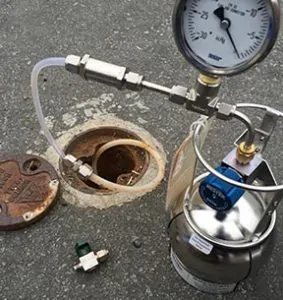

Marketing Specialist Dana Justice of SCS Engineers shares her favorite snack on Snacks with a Surprise while discussing Brownfields’ economic potential, the environmental impact, and the opportunity to serve communities through her support. Her work with SCS’s environmental consultants and engineers provides land remediation and Brownfields grants bringing properties with a past back to pristine condition. The redevelopment of these properties, typically with developed infrastructure already in place, provide jobs, housing, parks, and tax revenues for the surrounding community.
Learn more about the Urban Land Institutes’s Women’s Leadership Initiative or
more about Brownfield Remediation and Grants here.
Blighted properties are common in many urban areas, and with due diligence often present cost-effective and profitable redevelopment opportunities. Redevelopment of these types of projects is often referred to as Brownfield projects if considering the presence or potential presence of contaminants in the subsurface. Brownfields redevelopments can present great benefits and advantages to the surrounding community.

Advantages of the redevelopment of these properties include: revitalizing a property and surrounding properties, creating jobs, rejuvenating businesses, adding much-needed housing, increasing tax revenue, reducing crime, and increasing the efficiencies and quality of life for residents and workers.
Redevelopment of blighted properties does come with challenges, such as density, parking, financing, city approvals, and more. Blighted properties can have environmental issues that are best addressed proactively to reduce the risk of cost and schedule overruns as future liability issues during redevelopment.
These issues should start to be addressed during due diligence and before construction activities commence to reduce the uncertainty on potential project costs and timeline implications. Environmental issues can sidetrack the development process of some properties but most sites, if handled correctly, can present significant upside if these issues are identified during the due diligence and integrated into the development processes.
Common environmental concerns include:
Identifying environmental risks before the acquisition of properties is critical, as is assigning potential costs to these risks. Depending on the nature of the transaction, these items are often useful as leverage during negotiations.
A Phase I Environmental Site Assessment is a good starting place for identifying whether environmental issues may exist at a property. If a Phase I identifies potential risks, these reports may recommend additional investigation (Phase II) in the form of soil, soil vapor, and groundwater sampling. Phase II is used to identify whether contamination is present (i.e., from fuels, solvents, pesticides, toxic metals), and with enough sampling can determine the extent and magnitude of contamination.
Resolving these impacts can include leaving and managing impacted soil in place as much as possible since the significant cost from impacted soil is digging it up and paying to dispose of it. Regulatory agencies such as the local health departments, if approached under voluntary cleanup assistance programs, can accommodate leaving all or a good portion of impacted soil in place if the risks to human health and the environment are identified and resolved in a mitigation plan.
For more significant contamination issues, such as extensive soil and groundwater contamination from a gas station or dry cleaner releases, funding in the form of State or Federal grants can be available. Obtaining a grant with the help of a qualified environmental consultant can be the difference-maker in acquiring, cleaning up, and redeveloping a blighted property. These grants don’t typically cover all the costs associated with these cleanups but can cover the majority of these costs with some additional time required to do a cleanup.
Developers can also take out an environmental insurance policy to console a nervous lender or investor. Environmental insurance can cover clean-up requirements, third-party claims for bodily injury and property damage, and associated legal expenses resulting from pollution or contamination. Policies with various term lengths and deductible amounts are available to satisfy the concerns of lenders or equity investors.
The redevelopment of blighted urban properties is a necessary part of the life cycle of a property and a community. It’s critical to identify potential environmental risks during the due diligence process – before you choose to purchase the site. With proper planning, the mitigation or remediation of these impacts can be incorporated into the development process and result in a vibrant, profitable project that protects human health and the environment, and help owners, lenders, investors, and users of these properties sleep well at night.

Learn more about Brownfields | Learn more about Due Diligence
Joseph Dinan heads the SCS Engineers new office at 101 Arch Street, Boston, MA 02110,
Tel: 857-444-6302
SCS Engineers opened a new office in Boston’s Downtown Crossing district. The new location is more convenient for clients and enhances support to the firm’s growing client base in New England.

Joseph Dinan, an accomplished project manager and senior scientist heads Boston’s SCS team. Dinan has an excellent record meeting regulatory compliance and accountability for his clients to efficiently permit projects, keep them on budget and maintain the redevelopment schedule while meeting all environmental guidance. His background includes applied sciences including chemistry, microbiology, and environmental and soil sciences. Dinan has successfully managed hundreds of environmental assessment and remediation projects, both domestically and internationally.
Dinan’s Boston team resolves complex environmental challenges through the application of comprehensive analytical skills and technologies. Approaching each project with decades of expertise, mitigating the financial risk through careful assessment, analysis, and planning protects clients and the environment during all phases of redevelopment.
The Boston location supports the growing demand for environmental scientists, engineers, and consultants. SCS professional staff specializes in meeting federal, state, and local clean air, water, and soil goals, and the restoration of property once thought impractical to revitalize. The firm also provides vapor intrusion systems for protecting existing properties and a range of comprehensive environmental services for public and private entities.
As with most established urban environments, many properties may have previously been industrial or mass transportation sites, which often means that extra care is taken during redevelopment. Commercial real estate transactions must take environmental issues into consideration. Complex laws can impose significant environmental liabilities on purchasers, sellers, and lenders, whether or not they caused the problem, and whether or not they still own the property.
Important rules published by the U.S. Environmental Protection Agency – USEPA and in Massachusetts and other states offer defenses against environmental liabilities provided that the defendant conducted “all appropriate inquiries” regarding the property at the time of the acquisition, and then took reasonable steps to mitigate the effects of hazardous substances found on the property.
For more information, case studies, events, and articles visit these pages:
On October 19, 2018, the Treasury issued proposed guidance related to the new Opportunity Zone tax incentive created by the 2017 Tax Cuts and Jobs Act. Opportunity Zones are communities where new investments may be eligible for significant tax incentives. The incentive is designed to spur economic development and job creation.
New tax code Section 1400Z-1 provides the rules for designating Opportunity Zones and Section 1400Z-2 allows a taxpayer to elect to defer certain gains based on timely investment in Qualified Opportunity Fund (QOF) and excludes post-acquisition gains on investments in QOFs held for at least 10 years. The proposed guidance under Section 1400Z-2 addresses the gains eligible for deferral, types of taxpayers who are eligible, the type of eligible interest, the timeframe to invest in the QOF, and the requirement to include previously deferred gains. The proposed regulations also provide rules for self-certifying as a QOF, valuation of QOF assets (90% test), and guidance on qualified businesses. The proposed rule would permit an investor making an investment as late as the end of June 2027 to hold the investment in the QOF for the entire 10-year holding period plus another 10 years through 2047.
In a nutshell, the new law allows a taxpayer who would otherwise owe capital gains tax on an investment to roll-over the proceeds into an Opportunity Zone and thereby defer (or eliminate) capital gains taxes provided certain conditions are met. As many of the Opportunity Zones will be designated in areas containing Brownfields redevelopment opportunities, SCS expects many of our clients will be interested in this opportunity to do well by doing good. If you are interested in investing in a potential brownfield site, contact SCS Engineers to help you evaluate and manage environmental concerns associated with your site. Visit www.scsengineers.com to learn more.
The following are links to the press release and proposed guidance:
https://home.treasury.gov/news/press-releases/sm530
https://www.irs.gov/pub/irs-drop/reg-115420-18.pdf
The Treasury plans to present additional guidance before the end of the year, and a public hearing is scheduled for January 10, 2019. Taxpayers may submit comments by 60 days (around the third week in December 2018) after the publication of the proposed guidance in the Federal Register at www.regulations.gov. Additional guidance is expected to include the meaning of “substantially all”; transactions that may trigger the inclusion of gain that has been deferred; the reasonable period for a QOF to reinvest without paying a penalty; administrative rules regarding the investment standard; and, information-reporting requirements. SCS will provide an update when the additional guidance becomes available.
For additional information, you may contact SCS Engineers at or the blog Author, Christine Stokes.
Additional Resources:
Duluth, GA – SCS Engineers, a leader in environmental and solid waste engineering, recently relocated from Alpharetta to a larger, more strategically located office in Duluth, Georgia. The new office supports SCS’s continued development in the Southeast, our client success-driven growth, and accommodates our growing professional staff.
SCS is always on the lookout for talented senior level professionals in the environmental consulting community. The Atlanta Environmental Services (ES) group is seeking experienced, humble, hungry, and smart senior level consultants with client relationships and business development capabilities to join our team.
SCS Engineers – Atlanta
3175 Satellite Blvd
Building 600, Suite 100
Duluth, GA 30096
(678) 319-9849
If you are interested or know anybody who is interested, reach out to . You may also review our open positions on the SCS Careers Page.
Vapor intrusion (sometimes known as soil gas intrusion or soil vapor intrusion) is a potential environmental risk that can occur at a wide variety of properties, from former industrial facilities, shopping malls, and even residential properties. Knowing how to assess the risk and mitigate potential harm from soil vapor intrusion is critical to reducing health impacts and mitigating financial and other liability from potential exposures.
What is Vapor Intrusion?
Developers and the public understand that soil and water contamination can pose a health hazard, but vapor intrusion is an environmental health risk that can be overlooked. It is a hazard that can result from both heavy industrial operations and small “mom-and-pop” businesses so that it can be an issue both at industrial properties, suburban strip malls, and even residential developments.
Vapor intrusion is the migration of soil or water contamination from below structures into businesses or homes as a vapor. Common vapor intrusion contaminants from small businesses include benzene from gasoline and perchloroethylene (perc) from dry-cleaners, while large industrial facilities may have a wide range of industrial chemical contaminants. Less common vapor intrusion hazards are mercury, polychlorinated biphenyls, and pesticides.
Determining Whether Vapor Intrusion is an Issue
Environmental due diligence is key to determining whether vapor intrusion is a likely issue. An environmental site assessment (ESA) is critical in assessing the potential for vapor intrusion issues and the current state of vapor intrusion based on past site history. A Phase I ESA will review the current and historical use of the property and surrounding properties to determine where and when potential sources of contamination were present. Leaky underground gasoline storage tanks and poor chemical handling practices at dry cleaners lead to chemical contamination that can create vapor intrusion issues, so the “corner” gas station or the strip mall dry cleaner can be the source of vapor intrusion hazards.
Vapor intrusion can also come from groundwater plumes that originate outside the property boundary, so it is important that any assessment looks for potential contamination issues from nearby properties as well as on-site.
When the potential for a vapor intrusion issue exists, a Phase II ESA should be conducted to determine whether there is contamination, the extent and magnitude of the contamination, and whether the contamination poses a significant health risk. In the Phase II ESA, samples of soil and groundwater are collected from the property and analyzed for evidence of contamination.

If contamination is present, results are compared to screening levels established by regulatory agencies or a health risk assessment (HRA) can be prepared. Either of these strategies can potentially be used to demonstrate that health risks are not significant for the property’s current or future use or to determine the level of remediation necessary.
Dealing with Significant Soil Vapor Contamination
If soil vapor intrusion poses a significant health risk, there are ways to mitigate that risk. Mitigation can include removal of the contamination, active mitigation of the contamination source, and protection against indoor air exposure. The approaches are not mutually exclusive, and multiple risk reduction strategies may be used.
The most effective way of reducing soil vapor risk is to remove or treat the soil or water that is the source. This remediation is the most cost-effective for small sources of contamination and when that contamination can be easily accessed. It is often not feasible to remove the source when contamination originates offsite and moves onto the property in a groundwater plume. It may also be more cost-effective to mitigate risk through other means when the source of the vapor intrusion is extensive or difficult to remove.
In active mitigation, soil vapor intrusion is mitigating by reducing contamination at the source. Active systems can include soil vapor extraction, in which vapor is collected and removed; in situ treatment, which uses chemical reagents to transform the contamination into less toxic chemicals; and containment of the contamination source by some form of barrier. Under ideal conditions, these methods have the potential to be highly effective in reducing contamination but monitor treatment for effectiveness and to determine that the resulting contamination levels are acceptable.
It is also possible to mitigate indoor air exposure to soil vapor intrusion. Underground vents, membranes, and seals beneath the foundation and slab depressurization can reduce the flow of soil vapor into a building. This type of passive mitigation leaves the contamination source in place, which may limit future uses for the contaminated property, but it may be more cost-effective than active mitigation, especially in cases where contamination originates off the property. Regulatory agencies typically require that properties mitigating the movement of soil vapor into buildings monitor the ongoing mitigation on a continuous basis with sensors and alarms or periodic resampling.
What You Need to Know
Soil vapor intrusion is a potential environmental liability, but it is manageable. Environmental due diligence can significantly reduce unforeseen costs of vapor intrusion by identifying the issue for proactive management before development, which is always easier and more cost-effective than trying to address a problem after development. It is possible to mitigate health risk from soil vapor intrusion on developed sites. Developers should work with qualified environmental consultants to address vapor intrusion through each stage of the process to adequately minimize risk.
It is challenging to restore properties with a past, but you can do it on time and on budget if you plan ahead to address contaminated historic fill. Follow these tips and use the brownfield redevelopment checklist to keep your next redevelopment on track.
Design Phase
Consider how contaminated historic fill impacts the following:
Site feature locations – You can reduce or even eliminate landfill disposal costs by carefully selecting locations for your building, underground parking, parking lot, utility, and green space.
Storm water infiltration – Do you know that storm water infiltration devices must be located in areas free of contaminated historic fill? Infiltration devices cannot be located where contaminants of concern (as defined in s. NR 720.03(2)) are present in the soil through which the infiltration will occur.
Subslab vapor mitigation system – Already know you have contaminated historic fill on site? Consider adding a subslab vapor mitigation system to the design of your new building. It is usually much cheaper to install this system in a new building than to retrofit one into an existing building. It can also mitigate radon gas.
Planning & Design
Determine if contamination requires the following plans to manage the construction phase:
Material management plan – It establishes how you will separate excavated contaminated material from material that is not contaminated. It also outlines how you will handle contaminated material, either by disposing of it off site in a landfill or reusing it on site in an approved area such as a paved parking lot. This plan also covers screening, sampling, and testing contaminated materials, if required.
Dewatering plan – If the development requires excavation through contaminated historic fill to depths below groundwater, you will need a dewatering plan to properly manage discharge of the water. You may be able to discharge the water to the storm sewer or the sanitary sewer depending on the type and concentration of contaminants. You must determine local and state permit requirements before implementing your dewatering plan.
Demolition plan – The demolition plan for removing existing structures during redevelopment should include handling, removal, and disposal of potential contaminants such as lead and asbestos. The demolition plan should also address recycling and reuse of existing on site materials like concrete. You may be able to save money by crushing and reusing concrete on site as fill material, or by hauling and crushing it off site to reuse it as fill at another property. This approach can save you considerable money compared to landfill disposal.
Ready to start saving time and money addressing contaminated historic fill at your next redevelopment? Contact Ray Tierney for help evaluating your options in the Upper Midwest, or using the SCS Brownfield Redevelopment Checklist .
Live in another part of the country? SCS Engineers offers brownfields, remediation, due diligence, and all appropriate inquires services nationwide. Contact us today at .
Learn more about these services at SCS Engineers; read our case studies and articles:
Brownfields and Remediation
Due Diligence and All Appropriate Inquiries
Join an esteemed panel of redevelopment and land reuse experts for a practical and interactive workshop that will provide project managers, real-estate developers and investors, the public sector, and allied professionals with the tools, techniques, and funding resources required to bring projects in on time and on-budget.
The Center for Creative Land Recycling is offering a free half-day workshop and walking tour in Vista, CA focused on fostering economic development and creating vibrant communities through land reuse. The workshop focuses on economic development through infill and reuse of underutilized and potentially environmentally challenged properties, such as brownfields, to create stronger economies. Come and learn how to jump-start your community’s redevelopment programs.
Then, end your day with an urban brew-newal tour of brownfields that were redeveloped as affordable housing and breweries.
May 23, 2017, 1:00 pm – 4:00 pm
Vista Public Library
700 Eucalyptus Ave.
Vista, CA 92084
To register: Click Here
Did you know Wisconsin has more than 80,000 properties with a history of contamination or remediation? What if you could transform even the most challenged property into a center of economic prosperity? You can with three well-established reimbursement programs.
PECFA
The Petroleum Environmental Cleanup Fund Award (PECFA) program is administered by the Wisconsin Department of Natural Resources (WDNR) and is funded by a petroleum inspection fee. PECFA has provided funding for investigation and cleanup of petroleum contamination from petroleum product storage systems at tens of thousands of properties in Wisconsin since it started in the 1980s.
The WDNR estimates there are more than 100 eligible, enrolled sites that have stalled and are at risk of not being reimbursed for eligible costs. If you have an open PECFA project, and especially if you have a stalled PECFA project, act now or you may lose your funding. The program is closed to new applicants and will sunset on June 30, 2020. No claims will be accepted after this date.
ACCP
The Agricultural Chemical Cleanup Program (ACCP) provides financial assistance for agricultural chemical investigations and cleanups to property owners and people who have caused or own/control spilled agricultural chemical(s). Companies that apply for ACCP funds include ag-chem cooperatives, ag-chem transport companies, farm enterprises, and other ag-chem suppliers and users. Cleanup costs can be reimbursed at 75% of eligible costs between the deductible and the $400,000 discharge site maximum with a proposed increase to $600,000 per site maximum in the Governor’s 2017 budget. To qualify, you typically need a site investigation and remediation by a professional engineer and hydrogeologist.
DERF
The Dry Cleaner Environmental Response Fund (DERF) provides financial protection for Wisconsin dry cleaner owners if contamination occurred from their operations. The program began in 1997 and is funded by fees on dry-cleaning receipts and the solvents used in the dry-cleaning process. The maximum award is $500,000 per facility. DERF is closed to new applicants; however, eligible owners can still receive reimbursements for site investigation and remediation activities. The estimated reimbursement time is two to three years from claim submittal.
Thousands of Wisconsin property owners have used PECFA, ACCP, and DERF to address contamination on their properties. Contact SCS Engineers to learn how you can use these programs to ease your redevelopment costs.
Contacts in Wisconsin:
Ray Tierney, PG
608.216.7332
SCS Engineers’ Vice Presidents Tom Rappolt and Dan Johnson have collectively been named the 2015 IEA Associate of the Year by the Industrial Environmental Association (IEA) of San Diego. An award will be presented at the 31st Environmental Awards Luncheon on October 29, 2015, at the San Diego Convention Center.
IEA promotes responsible, cost-effective environmental laws and regulations, facilitates environmental compliance among member companies and provides educational activities for the San Diego community and Southern California.
“This award recognizes SCS Engineers’ many years of support for IEA and our mission,” said Meridith Marquis, President of IEA. “Several SCS staff members have provided critical technical expertise, helped IEA members and staff in evaluating the impacts of regulatory and legislative proposals, and actively participated in several IEA committees and conferences.”
Learn more about SCS Services by clicking here.